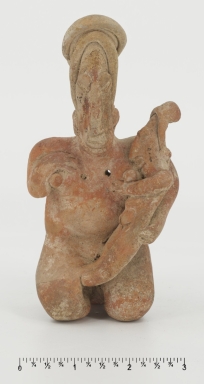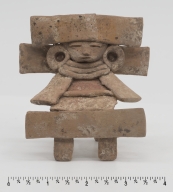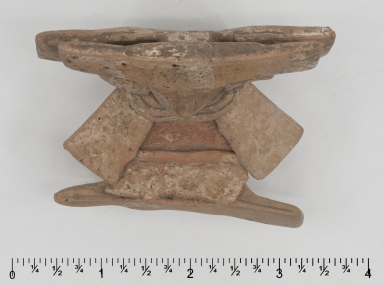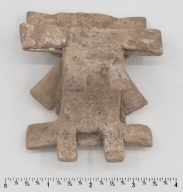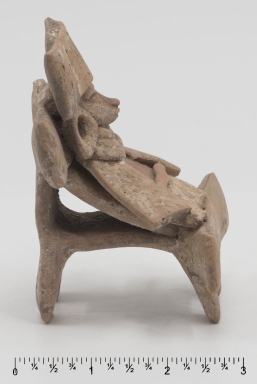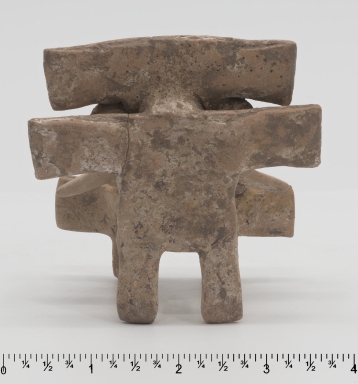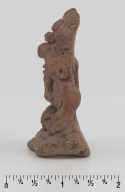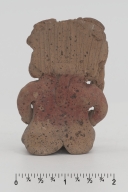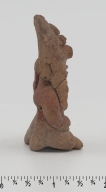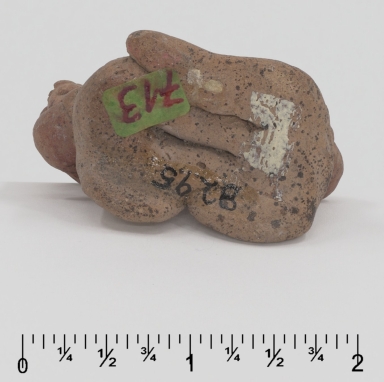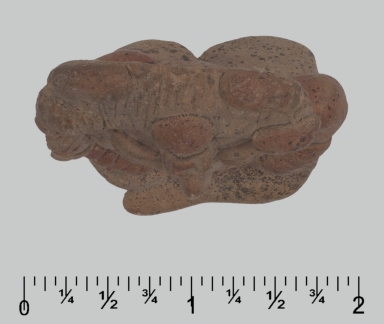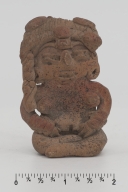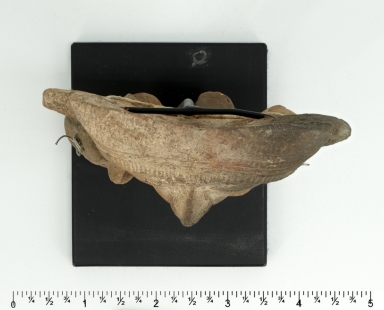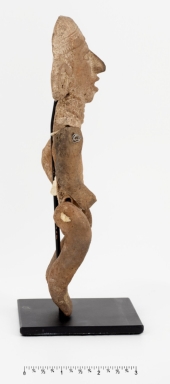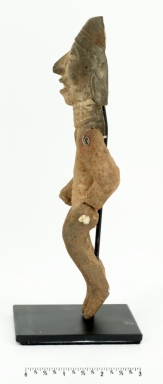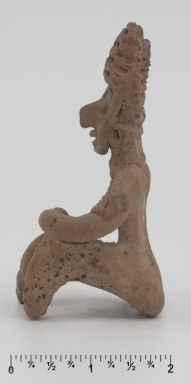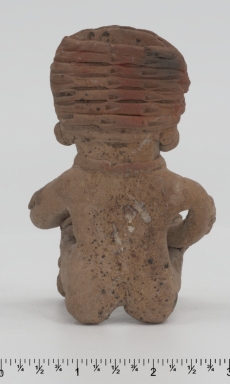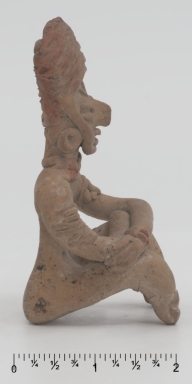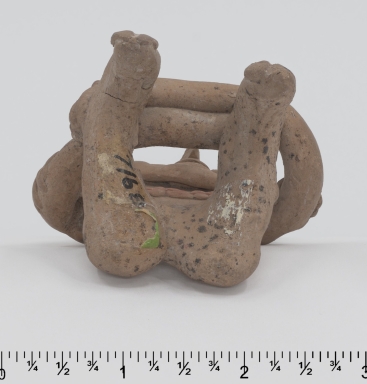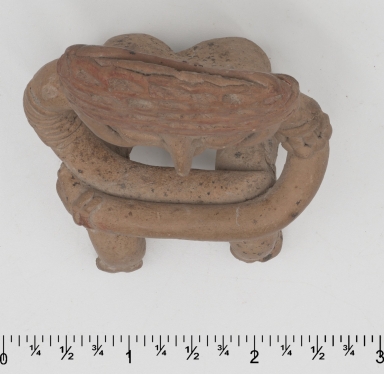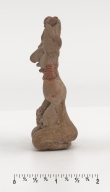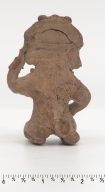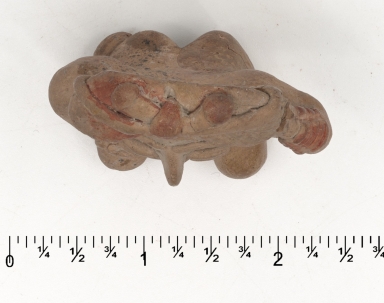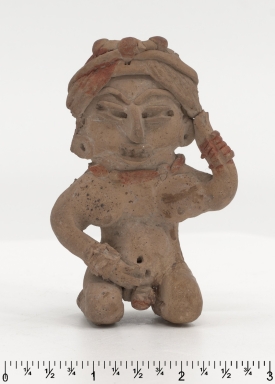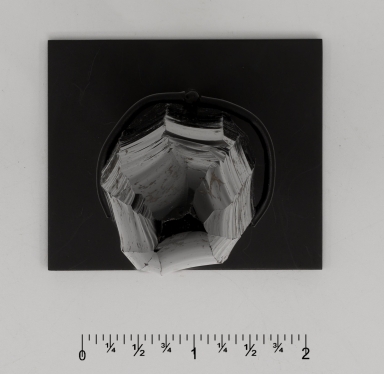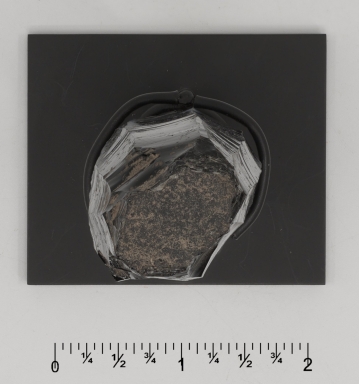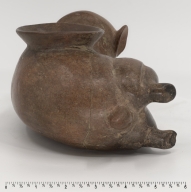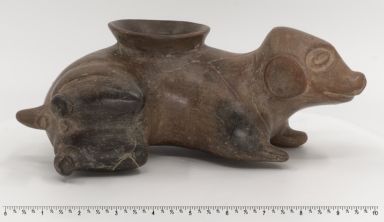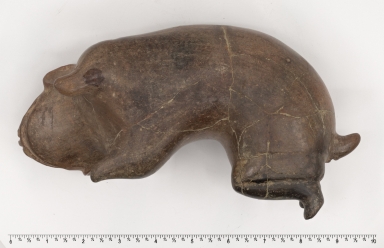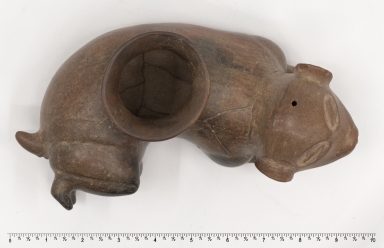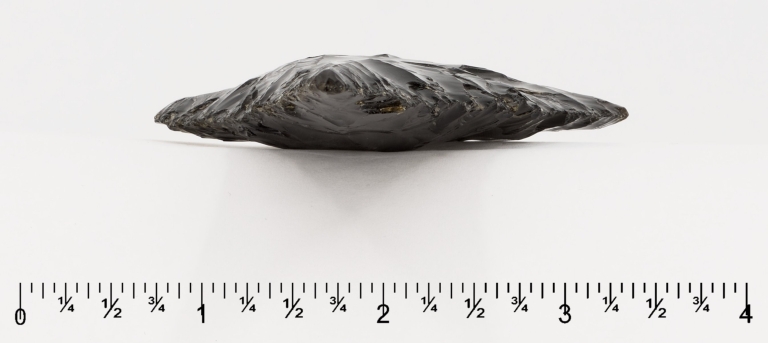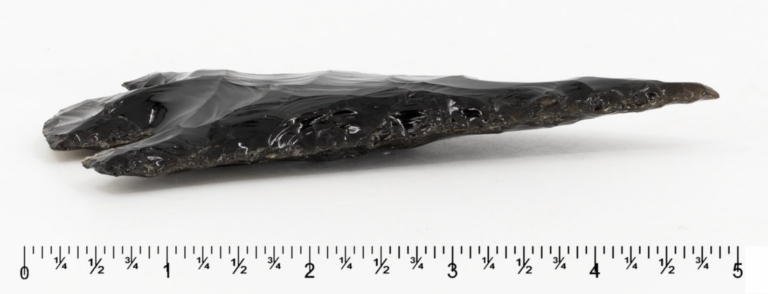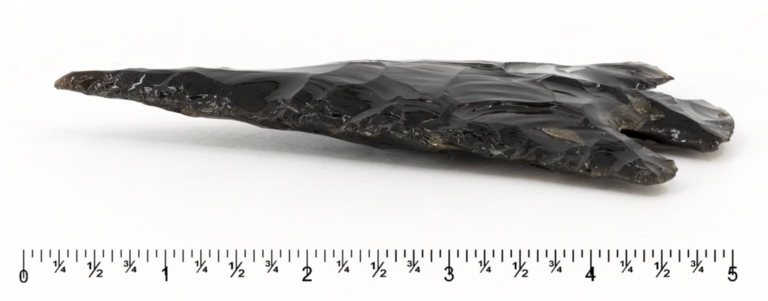|
Title
Mother and Child Pendant
Description
Kneeling mother holds her child to her breast. Her swollen belly or distended belly flap indicates a past pregnancy and her fertility.
Subject
[Indigenous peoples--Antiquities, Indigenous peoples--Antiquities]
Date
between 300 B.C. and 300 A.D.
Title
Small seated enthroned figure.
Description
Human figurines have been handmade at Teotihuacán since 150 BC. Around AD 250, the Teotihuacanos began mass-producing figures using molds. The figurines are not found in burials or temple complexes. The thousands that have been found in residential middens and fills suggest they were important in daily household rituals at the 2000 apartment complexes.
Subject
[Ceramic sculpture--Mexico--Teotihuacán Valley, Art--Mexico--Teotihuacán Valley, Indigenous peoples--Antiquities]
Date
between 150 and 750
Title
Small seated enthroned figure.
Description
Human figurines have been handmade at Teotihuacán since 150 BC. Around AD 250, the Teotihuacanos began mass-producing figures using molds. The figurines are not found in burials or temple complexes. The thousands that have been found in residential middens and fills suggest they were important in daily household rituals at the 2000 apartment complexes.
Subject
[Ceramic sculpture--Mexico--Teotihuacán Valley, Art--Mexico--Teotihuacán Valley, Indigenous peoples--Antiquities]
Date
between 150 and 750
Title
Small seated enthroned figure.
Description
Human figurines have been handmade at Teotihuacán since 150 BC. Around AD 250, the Teotihuacanos began mass-producing figures using molds. The figurines are not found in burials or temple complexes. The thousands that have been found in residential middens and fills suggest they were important in daily household rituals at the 2000 apartment complexes.
Subject
[Ceramic sculpture--Mexico--Teotihuacán Valley, Art--Mexico--Teotihuacán Valley, Indigenous peoples--Antiquities]
Date
between 150 and 750
Title
Small seated enthroned figure.
Description
Human figurines have been handmade at Teotihuacán since 150 BC. Around AD 250, the Teotihuacanos began mass-producing figures using molds. The figurines are not found in burials or temple complexes. The thousands that have been found in residential middens and fills suggest they were important in daily household rituals at the 2000 apartment complexes.
Subject
[Ceramic sculpture--Mexico--Teotihuacán Valley, Art--Mexico--Teotihuacán Valley, Indigenous peoples--Antiquities]
Date
between 150 and 750
Title
Small seated enthroned figure.
Description
Human figurines have been handmade at Teotihuacán since 150 BC. Around AD 250, the Teotihuacanos began mass-producing figures using molds. The figurines are not found in burials or temple complexes. The thousands that have been found in residential middens and fills suggest they were important in daily household rituals at the 2000 apartment complexes.
Subject
[Ceramic sculpture--Mexico--Teotihuacán Valley, Art--Mexico--Teotihuacán Valley, Indigenous peoples--Antiquities]
Date
between 150 and 750
Title
Small seated enthroned figure.
Description
Human figurines have been handmade at Teotihuacán since 150 BC. Around AD 250, the Teotihuacanos began mass-producing figures using molds. The figurines are not found in burials or temple complexes. The thousands that have been found in residential middens and fills suggest they were important in daily household rituals at the 2000 apartment complexes.
Subject
[Ceramic sculpture--Mexico--Teotihuacán Valley, Art--Mexico--Teotihuacán Valley, Indigenous peoples--Antiquities]
Date
between 150 and 750
Title
Seated female figure : hair braided on right side.
Description
A nude female sits with crossed legs wearing a headdress with ornaments, braided hair with hair ornaments, ear spools, and several bracelets. Her slightly swollen belly indicates pregnancy or a past pregnancy (belly flap).
Subject
[Ceramic sculpture--Mexico--Teotihuacán Valley, Art--Mexico--Teotihuacán Valley, Indigenous peoples--Antiquities]
Date
between 500 B.C. and 200 B.C.
Title
Seated female figure : hair braided on right side.
Description
A nude female sits with crossed legs wearing a headdress with ornaments, braided hair with hair ornaments, ear spools, and several bracelets. Her slightly swollen belly indicates pregnancy or a past pregnancy (belly flap).
Subject
[Ceramic sculpture--Mexico--Teotihuacán Valley, Art--Mexico--Teotihuacán Valley, Indigenous peoples--Antiquities]
Date
between 500 B.C. and 200 B.C.
Title
Seated female figure : hair braided on right side.
Description
A nude female sits with crossed legs wearing a headdress with ornaments, braided hair with hair ornaments, ear spools, and several bracelets. Her slightly swollen belly indicates pregnancy or a past pregnancy (belly flap).
Subject
[Ceramic sculpture--Mexico--Teotihuacán Valley, Art--Mexico--Teotihuacán Valley, Indigenous peoples--Antiquities]
Date
between 500 B.C. and 200 B.C.
Title
Seated female figure : hair braided on right side.
Description
A nude female sits with crossed legs wearing a headdress with ornaments, braided hair with hair ornaments, ear spools, and several bracelets. Her slightly swollen belly indicates pregnancy or a past pregnancy (belly flap).
Subject
[Ceramic sculpture--Mexico--Teotihuacán Valley, Art--Mexico--Teotihuacán Valley, Indigenous peoples--Antiquities]
Date
between 500 B.C. and 200 B.C.
Title
Seated female figure : hair braided on right side.
Description
A nude female sits with crossed legs wearing a headdress with ornaments, braided hair with hair ornaments, ear spools, and several bracelets. Her slightly swollen belly indicates pregnancy or a past pregnancy (belly flap).
Subject
[Ceramic sculpture--Mexico--Teotihuacán Valley, Art--Mexico--Teotihuacán Valley, Indigenous peoples--Antiquities]
Date
between 500 B.C. and 200 B.C.
Title
Seated female figure : hair braided on right side.
Description
A nude female sits with crossed legs wearing a headdress with ornaments, braided hair with hair ornaments, ear spools, and several bracelets. Her slightly swollen belly indicates pregnancy or a past pregnancy (belly flap).
Subject
[Ceramic sculpture--Mexico--Teotihuacán Valley, Art--Mexico--Teotihuacán Valley, Indigenous peoples--Antiquities]
Date
between 500 B.C. and 200 B.C.
Title
Medium articulated figure.
Description
Articulated figures are found in burials usually in pairs indicating some sort of funerary function. The majority of the figures are female and if lines appear on the lower body that would indicate a previous birth. The head and body unit is mold-made, while the arms and legs are hand-made. Teotihuacan figures have a clefted head or headdress, a Teotihuacan face, ear spools and a collar necklace.
Subject
[Ceramic sculpture--Mexico--Teotihuacán Valley, Art--Mexico--Teotihuacán Valley, Indigenous peoples--Antiquities]
Date
between 150 and 750
Title
Medium articulated figure.
Description
Articulated figures are found in burials usually in pairs indicating some sort of funerary function. The majority of the figures are female and if lines appear on the lower body that would indicate a previous birth. The head and body unit is mold-made, while the arms and legs are hand-made. Teotihuacan figures have a clefted head or headdress, a Teotihuacan face, ear spools and a collar necklace.
Subject
[Ceramic sculpture--Mexico--Teotihuacán Valley, Art--Mexico--Teotihuacán Valley, Indigenous peoples--Antiquities]
Date
between 150 and 750
Title
Medium articulated figure.
Description
Articulated figures are found in burials usually in pairs indicating some sort of funerary function. The majority of the figures are female and if lines appear on the lower body that would indicate a previous birth. The head and body unit is mold-made, while the arms and legs are hand-made. Teotihuacan figures have a clefted head or headdress, a Teotihuacan face, ear spools and a collar necklace.
Subject
[Ceramic sculpture--Mexico--Teotihuacán Valley, Art--Mexico--Teotihuacán Valley, Indigenous peoples--Antiquities]
Date
between 150 and 750
Title
Medium articulated figure.
Description
Articulated figures are found in burials usually in pairs indicating some sort of funerary function. The majority of the figures are female and if lines appear on the lower body that would indicate a previous birth. The head and body unit is mold-made, while the arms and legs are hand-made. Teotihuacan figures have a clefted head or headdress, a Teotihuacan face, ear spools and a collar necklace.
Subject
[Ceramic sculpture--Mexico--Teotihuacán Valley, Art--Mexico--Teotihuacán Valley, Indigenous peoples--Antiquities]
Date
between 150 and 750
Title
Medium articulated figure.
Description
Articulated figures are found in burials usually in pairs indicating some sort of funerary function. The majority of the figures are female and if lines appear on the lower body that would indicate a previous birth. The head and body unit is mold-made, while the arms and legs are hand-made. Teotihuacan figures have a clefted head or headdress, a Teotihuacan face, ear spools and a collar necklace.
Subject
[Ceramic sculpture--Mexico--Teotihuacán Valley, Art--Mexico--Teotihuacán Valley, Indigenous peoples--Antiquities]
Date
between 150 and 750
Title
Medium articulated figure.
Description
Articulated figures are found in burials usually in pairs indicating some sort of funerary function. The majority of the figures are female and if lines appear on the lower body that would indicate a previous birth. The head and body unit is mold-made, while the arms and legs are hand-made. Teotihuacan figures have a clefted head or headdress, a Teotihuacan face, ear spools and a collar necklace.
Subject
[Ceramic sculpture--Mexico--Teotihuacán Valley, Art--Mexico--Teotihuacán Valley, Indigenous peoples--Antiquities]
Date
between 150 and 750
Title
Seated male figure with crossed arms.
Description
A nude male sits with his knees drawn up to his chest. His left arm rests on his knees. He wears an assortment of jewelry and the chinstrap headdress suggests a ballplayer. The habit of sitting with drawn knees and arms resting on them is a very typical posture in Mesoamerican sculpture.
Subject
[Ceramic sculpture--Mexico--Teotihuacán Valley, Art--Mexico--Teotihuacán Valley, Indigenous peoples--Antiquities]
Date
between 500 B.C. and 200 B.C.
Title
Seated male figure with crossed arms.
Description
A nude male sits with his knees drawn up to his chest. His left arm rests on his knees. He wears an assortment of jewelry and the chinstrap headdress suggests a ballplayer. The habit of sitting with drawn knees and arms resting on them is a very typical posture in Mesoamerican sculpture.
Subject
[Ceramic sculpture--Mexico--Teotihuacán Valley, Art--Mexico--Teotihuacán Valley, Indigenous peoples--Antiquities]
Date
between 500 B.C. and 200 B.C.
Title
Seated male figure with crossed arms.
Description
A nude male sits with his knees drawn up to his chest. His left arm rests on his knees. He wears an assortment of jewelry and the chinstrap headdress suggests a ballplayer. The habit of sitting with drawn knees and arms resting on them is a very typical posture in Mesoamerican sculpture.
Subject
[Ceramic sculpture--Mexico--Teotihuacán Valley, Art--Mexico--Teotihuacán Valley, Indigenous peoples--Antiquities]
Date
between 500 B.C. and 200 B.C.
Title
Seated male figure with crossed arms.
Description
A nude male sits with his knees drawn up to his chest. His left arm rests on his knees. He wears an assortment of jewelry and the chinstrap headdress suggests a ballplayer. The habit of sitting with drawn knees and arms resting on them is a very typical posture in Mesoamerican sculpture.
Subject
[Ceramic sculpture--Mexico--Teotihuacán Valley, Art--Mexico--Teotihuacán Valley, Indigenous peoples--Antiquities]
Date
between 500 B.C. and 200 B.C.
Title
Seated male figure with crossed arms.
Description
A nude male sits with his knees drawn up to his chest. His left arm rests on his knees. He wears an assortment of jewelry and the chinstrap headdress suggests a ballplayer. The habit of sitting with drawn knees and arms resting on them is a very typical posture in Mesoamerican sculpture.
Subject
[Ceramic sculpture--Mexico--Teotihuacán Valley, Art--Mexico--Teotihuacán Valley, Indigenous peoples--Antiquities]
Date
between 500 B.C. and 200 B.C.
Title
Seated male figure with crossed arms.
Description
A nude male sits with his knees drawn up to his chest. His left arm rests on his knees. He wears an assortment of jewelry and the chinstrap headdress suggests a ballplayer. The habit of sitting with drawn knees and arms resting on them is a very typical posture in Mesoamerican sculpture.
Subject
[Ceramic sculpture--Mexico--Teotihuacán Valley, Art--Mexico--Teotihuacán Valley, Indigenous peoples--Antiquities]
Date
between 500 B.C. and 200 B.C.
Title
Kneeling female figure giving birth.
Description
In Spanish, you would say "dar a luz" or "to give light" and in English "to give birth." The Mesoamericans considered the womb like a cave and the birthing process emerging into the light or life, in other words, resurrection. The position of the left hand to the head and the right hand on her abdomen describes an iconic position for childbirth in Mesoamerica.
Subject
[Ceramic sculpture--Mexico--Teotihuacán Valley, Art--Mexico--Teotihuacán Valley, Indigenous peoples--Antiquities]
Date
between 500 B.C. and 200 B.C.
Title
Kneeling female figure giving birth.
Description
In Spanish, you would say "dar a luz" or "to give light" and in English "to give birth." The Mesoamericans considered the womb like a cave and the birthing process emerging into the light or life, in other words, resurrection. The position of the left hand to the head and the right hand on her abdomen describes an iconic position for childbirth in Mesoamerica.
Subject
[Ceramic sculpture--Mexico--Teotihuacán Valley, Art--Mexico--Teotihuacán Valley, Indigenous peoples--Antiquities]
Date
between 500 B.C. and 200 B.C.
Title
Kneeling female figure giving birth.
Description
In Spanish, you would say "dar a luz" or "to give light" and in English "to give birth." The Mesoamericans considered the womb like a cave and the birthing process emerging into the light or life, in other words, resurrection. The position of the left hand to the head and the right hand on her abdomen describes an iconic position for childbirth in Mesoamerica.
Subject
[Ceramic sculpture--Mexico--Teotihuacán Valley, Art--Mexico--Teotihuacán Valley, Indigenous peoples--Antiquities]
Date
between 500 B.C. and 200 B.C.
Title
Kneeling female figure giving birth.
Description
In Spanish, you would say "dar a luz" or "to give light" and in English "to give birth." The Mesoamericans considered the womb like a cave and the birthing process emerging into the light or life, in other words, resurrection. The position of the left hand to the head and the right hand on her abdomen describes an iconic position for childbirth in Mesoamerica.
Subject
[Ceramic sculpture--Mexico--Teotihuacán Valley, Art--Mexico--Teotihuacán Valley, Indigenous peoples--Antiquities]
Date
between 500 B.C. and 200 B.C.
Title
Kneeling female figure giving birth.
Description
In Spanish, you would say "dar a luz" or "to give light" and in English "to give birth." The Mesoamericans considered the womb like a cave and the birthing process emerging into the light or life, in other words, resurrection. The position of the left hand to the head and the right hand on her abdomen describes an iconic position for childbirth in Mesoamerica.
Subject
[Ceramic sculpture--Mexico--Teotihuacán Valley, Art--Mexico--Teotihuacán Valley, Indigenous peoples--Antiquities]
Date
between 500 B.C. and 200 B.C.
Title
Kneeling female figure giving birth.
Description
In Spanish, you would say "dar a luz" or "to give light" and in English "to give birth." The Mesoamericans considered the womb like a cave and the birthing process emerging into the light or life, in other words, resurrection. The position of the left hand to the head and the right hand on her abdomen describes an iconic position for childbirth in Mesoamerica.
Subject
[Ceramic sculpture--Mexico--Teotihuacán Valley, Art--Mexico--Teotihuacán Valley, Indigenous peoples--Antiquities]
Date
between 500 B.C. and 200 B.C.
Title
Obsidian core.
Description
Obsidian, the stone of choice for making cutting tools, produced very sharp blades. The striking surfaces of this core has been oxidized. Long uniform blades have been pressure flaked from the core, running the length of the core. One blade did not reach the top of the core and broke prematurely.
Subject
[Stone carving--Mexico, Weapons--Mexico, Obsidian, Indigenous peoples--Antiquities]
Date
between 250 and 900
Title
Obsidian core.
Description
Obsidian, the stone of choice for making cutting tools, produced very sharp blades. The striking surfaces of this core has been oxidized. Long uniform blades have been pressure flaked from the core, running the length of the core. One blade did not reach the top of the core and broke prematurely.
Subject
[Stone carving--Mexico, Weapons--Mexico, Obsidian, Indigenous peoples--Antiquities]
Date
between 250 and 900
Title
Obsidian core.
Description
Obsidian, the stone of choice for making cutting tools, produced very sharp blades. The striking surfaces of this core has been oxidized. Long uniform blades have been pressure flaked from the core, running the length of the core. One blade did not reach the top of the core and broke prematurely.
Subject
[Stone carving--Mexico, Weapons--Mexico, Obsidian, Indigenous peoples--Antiquities]
Date
between 250 and 900
Title
Obsidian core.
Description
Obsidian, the stone of choice for making cutting tools, produced very sharp blades. The striking surfaces of this core has been oxidized. Long uniform blades have been pressure flaked from the core, running the length of the core. One blade did not reach the top of the core and broke prematurely.
Subject
[Stone carving--Mexico, Weapons--Mexico, Obsidian, Indigenous peoples--Antiquities]
Date
between 250 and 900
Title
Obsidian core.
Description
Obsidian, the stone of choice for making cutting tools, produced very sharp blades. The striking surfaces of this core has been oxidized. Long uniform blades have been pressure flaked from the core, running the length of the core. One blade did not reach the top of the core and broke prematurely.
Subject
[Stone carving--Mexico, Weapons--Mexico, Obsidian, Indigenous peoples--Antiquities]
Date
between 250 and 900
Title
Obsidian core.
Description
Obsidian, the stone of choice for making cutting tools, produced very sharp blades. The striking surfaces of this core has been oxidized. Long uniform blades have been pressure flaked from the core, running the length of the core. One blade did not reach the top of the core and broke prematurely.
Subject
[Stone carving--Mexico, Weapons--Mexico, Obsidian, Indigenous peoples--Antiquities]
Date
between 250 and 900
Title
Reclining female puppy.
Description
Potters produced thousands of thin orangeware effigy vessels. The curled-up dog with a rounded opening in the center of the dog's back became the most popular effigy. Many Mesoamericans believe dogs led the dead through the underworld after death. Either sculptures of dogs or real dogs were placed in many Teotihuacanos burials.
Subject
[Ceramic sculpture--Mexico--Teotihuacán Valley, Art--Mexico--Teotihuacán Valley, Indigenous peoples--Antiquities]
Date
between 150 and 750
Title
Reclining female puppy.
Description
Potters produced thousands of thin orangeware effigy vessels. The curled-up dog with a rounded opening in the center of the dog's back became the most popular effigy. Many Mesoamericans believe dogs led the dead through the underworld after death. Either sculptures of dogs or real dogs were placed in many Teotihuacanos burials.
Subject
[Ceramic sculpture--Mexico--Teotihuacán Valley, Art--Mexico--Teotihuacán Valley, Indigenous peoples--Antiquities]
Date
between 150 and 750
Title
Reclining female puppy.
Description
Potters produced thousands of thin orangeware effigy vessels. The curled-up dog with a rounded opening in the center of the dog's back became the most popular effigy. Many Mesoamericans believe dogs led the dead through the underworld after death. Either sculptures of dogs or real dogs were placed in many Teotihuacanos burials.
Subject
[Ceramic sculpture--Mexico--Teotihuacán Valley, Art--Mexico--Teotihuacán Valley, Indigenous peoples--Antiquities]
Date
between 150 and 750
Title
Reclining female puppy.
Description
Potters produced thousands of thin orangeware effigy vessels. The curled-up dog with a rounded opening in the center of the dog's back became the most popular effigy. Many Mesoamericans believe dogs led the dead through the underworld after death. Either sculptures of dogs or real dogs were placed in many Teotihuacanos burials.
Subject
[Ceramic sculpture--Mexico--Teotihuacán Valley, Art--Mexico--Teotihuacán Valley, Indigenous peoples--Antiquities]
Date
between 150 and 750
Title
Reclining female puppy.
Description
Potters produced thousands of thin orangeware effigy vessels. The curled-up dog with a rounded opening in the center of the dog's back became the most popular effigy. Many Mesoamericans believe dogs led the dead through the underworld after death. Either sculptures of dogs or real dogs were placed in many Teotihuacanos burials.
Subject
[Ceramic sculpture--Mexico--Teotihuacán Valley, Art--Mexico--Teotihuacán Valley, Indigenous peoples--Antiquities]
Date
between 150 and 750
Title
Reclining female puppy.
Description
Potters produced thousands of thin orangeware effigy vessels. The curled-up dog with a rounded opening in the center of the dog's back became the most popular effigy. Many Mesoamericans believe dogs led the dead through the underworld after death. Either sculptures of dogs or real dogs were placed in many Teotihuacanos burials.
Subject
[Ceramic sculpture--Mexico--Teotihuacán Valley, Art--Mexico--Teotihuacán Valley, Indigenous peoples--Antiquities]
Date
between 150 and 750
Title
Projectile point : green obsidian.
Description
The only source for green obsidian is located at Pachuca in the modern Mexican state of Hidalgo near Teotihuacan. The point was formed by core flaking and refined with pressure flaking. The Pachuca source was controlled by the Teotihuacanos during the Classic period and later by the Toltecas and Aztecas during the Post Classic period.
Subject
[Stone carving--Mexico--Hidalgo (State), Obsidian, Indigenous peoples--Antiquities]
Date
between 250 and 1521
Title
Projectile point : green obsidian.
Description
The only source for green obsidian is located at Pachuca in the modern Mexican state of Hidalgo near Teotihuacan. The point was formed by core flaking and refined with pressure flaking. The Pachuca source was controlled by the Teotihuacanos during the Classic period and later by the Toltecas and Aztecas during the Post Classic period.
Subject
[Stone carving--Mexico--Hidalgo (State), Obsidian, Indigenous peoples--Antiquities]
Date
between 250 and 1521
Title
Projectile point : green obsidian.
Description
The only source for green obsidian is located at Pachuca in the modern Mexican state of Hidalgo near Teotihuacan. The point was formed by core flaking and refined with pressure flaking. The Pachuca source was controlled by the Teotihuacanos during the Classic period and later by the Toltecas and Aztecas during the Post Classic period.
Subject
[Stone carving--Mexico--Hidalgo (State), Obsidian, Indigenous peoples--Antiquities]
Date
between 250 and 1521
Title
Projectile point : green obsidian.
Description
The only source for green obsidian is located at Pachuca in the modern Mexican state of Hidalgo near Teotihuacan. The point was formed by core flaking and refined with pressure flaking. The Pachuca source was controlled by the Teotihuacanos during the Classic period and later by the Toltecas and Aztecas during the Post Classic period.
Subject
[Stone carving--Mexico--Hidalgo (State), Obsidian, Indigenous peoples--Antiquities]
Date
between 250 and 1521
Title
Projectile point : green obsidian.
Description
The only source for green obsidian is located at Pachuca in the modern Mexican state of Hidalgo near Teotihuacan. The point was formed by core flaking and refined with pressure flaking. The Pachuca source was controlled by the Teotihuacanos during the Classic period and later by the Toltecas and Aztecas during the Post Classic period.
Subject
[Stone carving--Mexico--Hidalgo (State), Obsidian, Indigenous peoples--Antiquities]
Date
between 250 and 1521
Title
Projectile point : green obsidian.
Description
The only source for green obsidian is located at Pachuca in the modern Mexican state of Hidalgo near Teotihuacan. The point was formed by core flaking and refined with pressure flaking. The Pachuca source was controlled by the Teotihuacanos during the Classic period and later by the Toltecas and Aztecas during the Post Classic period.
Subject
[Stone carving--Mexico--Hidalgo (State), Obsidian, Indigenous peoples--Antiquities]
Date
between 250 and 1521
Title
Standing male figure : ballplayer.
Description
A male Chupicuaro figure wears a headdress, a wrapped left arm, and a left knee pad. He wears the basic equipment needed to play the Mesoamerican ballgame with a rubber ball.
Subject
[Ceramic sculpture--Mexico--Chupícuaro (Guanajuato), Art--Mexico--Chupícuaro (Guanajuato), Indigenous peoples--Antiquities]
Date
200 B.C. and 1 B.C
|
